GMC SIERRA 2010 Owner's Manual
Manufacturer: GMC, Model Year: 2010, Model line: SIERRA, Model: GMC SIERRA 2010Pages: 630, PDF Size: 4.65 MB
Page 421 of 630
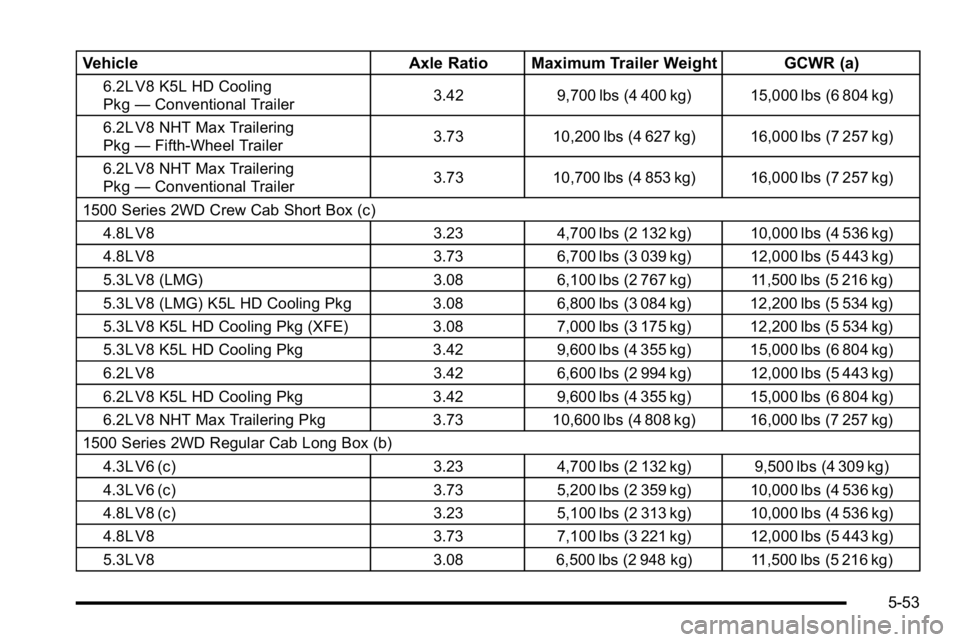
VehicleAxle Ratio Maximum Trailer Weight GCWR (a)
6.2L V8 K5L HD Cooling
Pkg—Conventional Trailer 3.42 9,700 lbs (4 400 kg) 15,000 lbs (6 804 kg)
6.2L V8 NHT Max Trailering
Pkg —Fifth-Wheel Trailer 3.73 10,200 lbs (4 627 kg) 16,000 lbs (7 257 kg)
6.2L V8 NHT Max Trailering
Pkg —Conventional Trailer 3.73 10,700 lbs (4 853 kg) 16,000 lbs (7 257 kg)
1500 Series 2WD Crew Cab Short Box (c) 4.8L V8 3.23 4,700 lbs (2 132 kg) 10,000 lbs (4 536 kg)
4.8L V8 3.73 6,700 lbs (3 039 kg) 12,000 lbs (5 443 kg)
5.3L V8 (LMG) 3.08 6,100 lbs (2 767 kg) 11,500 lbs (5 216 kg)
5.3L V8 (LMG) K5L HD Cooling Pkg 3.08 6,800 lbs (3 084 kg) 12,200 lbs (5 534 kg)
5.3L V8 K5L HD Cooling Pkg (XFE) 3.08 7,000 lbs (3 175 kg) 12,200 lbs (5 534 kg)
5.3L V8 K5L HD Cooling Pkg 3.42 9,600 lbs (4 355 kg) 15,000 lbs (6 804 kg)
6.2L V8 3.42 6,600 lbs (2 994 kg) 12,000 lbs (5 443 kg)
6.2L V8 K5L HD Cooling Pkg 3.42 9,600 lbs (4 355 kg) 15,000 lbs (6 804 kg)
6.2L V8 NHT Max Trailering Pkg 3.73 10,600 lbs (4 808 kg) 16,000 lbs (7 257 kg)
1500 Series 2WD Regular Cab Long Box (b) 4.3L V6 (c) 3.23 4,700 lbs (2 132 kg) 9,500 lbs (4 309 kg)
4.3L V6 (c) 3.73 5,200 lbs (2 359 kg) 10,000 lbs (4 536 kg)
4.8L V8 (c) 3.23 5,100 lbs (2 313 kg) 10,000 lbs (4 536 kg)
4.8L V8 3.73 7,100 lbs (3 221 kg) 12,000 lbs (5 443 kg)
5.3L V8 3.08 6,500 lbs (2 948 kg) 11,500 lbs (5 216 kg)
5-53
Page 422 of 630
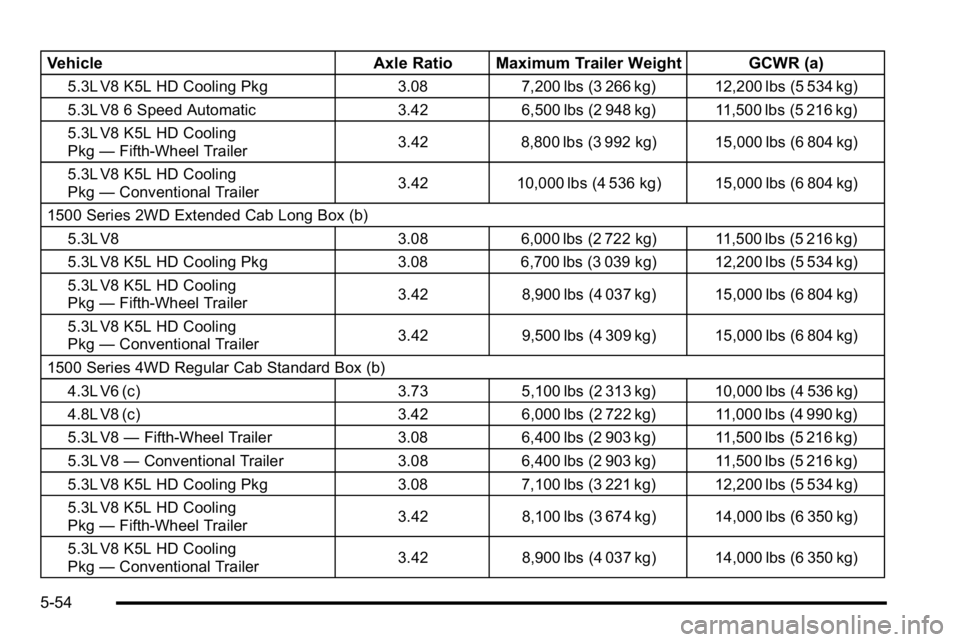
VehicleAxle Ratio Maximum Trailer Weight GCWR (a)
5.3L V8 K5L HD Cooling Pkg 3.087,200 lbs (3 266 kg) 12,200 lbs (5 534 kg)
5.3L V8 6 Speed Automatic 3.426,500 lbs (2 948 kg) 11,500 lbs (5 216 kg)
5.3L V8 K5L HD Cooling
Pkg —Fifth-Wheel Trailer 3.42
8,800 lbs (3 992 kg) 15,000 lbs (6 804 kg)
5.3L V8 K5L HD Cooling
Pkg —Conventional Trailer 3.42
10,000 lbs (4 536 kg) 15,000 lbs (6 804 kg)
1500 Series 2WD Extended Cab Long Box (b) 5.3L V8 3.086,000 lbs (2 722 kg) 11,500 lbs (5 216 kg)
5.3L V8 K5L HD Cooling Pkg 3.086,700 lbs (3 039 kg) 12,200 lbs (5 534 kg)
5.3L V8 K5L HD Cooling
Pkg —Fifth-Wheel Trailer 3.42
8,900 lbs (4 037 kg) 15,000 lbs (6 804 kg)
5.3L V8 K5L HD Cooling
Pkg —Conventional Trailer 3.42
9,500 lbs (4 309 kg) 15,000 lbs (6 804 kg)
1500 Series 4WD Regular Cab Standard Box (b) 4.3L V6 (c) 3.735,100 lbs (2 313 kg) 10,000 lbs (4 536 kg)
4.8L V8 (c) 3.426,000 lbs (2 722 kg) 11,000 lbs (4 990 kg)
5.3L V8 —Fifth-Wheel Trailer 3.086,400 lbs (2 903 kg) 11,500 lbs (5 216 kg)
5.3L V8 —Conventional Trailer 3.086,400 lbs (2 903 kg) 11,500 lbs (5 216 kg)
5.3L V8 K5L HD Cooling Pkg 3.087,100 lbs (3 221 kg) 12,200 lbs (5 534 kg)
5.3L V8 K5L HD Cooling
Pkg —Fifth-Wheel Trailer 3.42
8,100 lbs (3 674 kg) 14,000 lbs (6 350 kg)
5.3L V8 K5L HD Cooling
Pkg —Conventional Trailer 3.42
8,900 lbs (4 037 kg) 14,000 lbs (6 350 kg)
5-54
Page 423 of 630
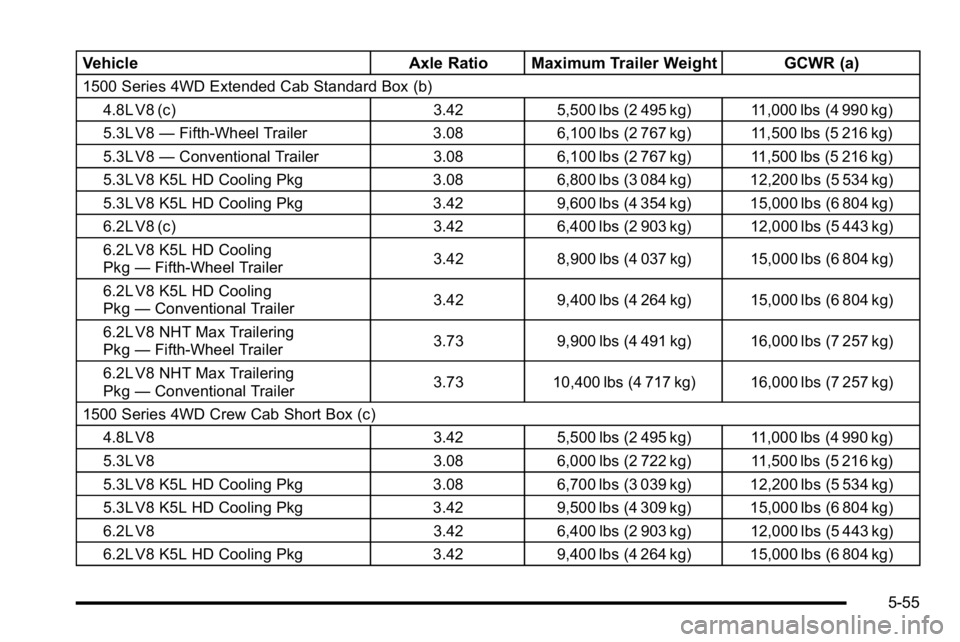
VehicleAxle Ratio Maximum Trailer Weight GCWR (a)
1500 Series 4WD Extended Cab Standard Box (b)
4.8L V8 (c) 3.42 5,500 lbs (2 495 kg) 11,000 lbs (4 990 kg)
5.3L V8 —Fifth-Wheel Trailer 3.08 6,100 lbs (2 767 kg) 11,500 lbs (5 216 kg)
5.3L V8 —Conventional Trailer 3.086,100 lbs (2 767 kg) 11,500 lbs (5 216 kg)
5.3L V8 K5L HD Cooling Pkg 3.086,800 lbs (3 084 kg) 12,200 lbs (5 534 kg)
5.3L V8 K5L HD Cooling Pkg 3.429,600 lbs (4 354 kg) 15,000 lbs (6 804 kg)
6.2L V8 (c) 3.426,400 lbs (2 903 kg) 12,000 lbs (5 443 kg)
6.2L V8 K5L HD Cooling
Pkg —Fifth-Wheel Trailer 3.42
8,900 lbs (4 037 kg) 15,000 lbs (6 804 kg)
6.2L V8 K5L HD Cooling
Pkg —Conventional Trailer 3.42
9,400 lbs (4 264 kg) 15,000 lbs (6 804 kg)
6.2L V8 NHT Max Trailering
Pkg —Fifth-Wheel Trailer 3.73
9,900 lbs (4 491 kg) 16,000 lbs (7 257 kg)
6.2L V8 NHT Max Trailering
Pkg —Conventional Trailer 3.73
10,400 lbs (4 717 kg) 16,000 lbs (7 257 kg)
1500 Series 4WD Crew Cab Short Box (c) 4.8L V8 3.425,500 lbs (2 495 kg) 11,000 lbs (4 990 kg)
5.3L V8 3.086,000 lbs (2 722 kg) 11,500 lbs (5 216 kg)
5.3L V8 K5L HD Cooling Pkg 3.086,700 lbs (3 039 kg) 12,200 lbs (5 534 kg)
5.3L V8 K5L HD Cooling Pkg 3.429,500 lbs (4 309 kg) 15,000 lbs (6 804 kg)
6.2L V8 3.426,400 lbs (2 903 kg) 12,000 lbs (5 443 kg)
6.2L V8 K5L HD Cooling Pkg 3.429,400 lbs (4 264 kg) 15,000 lbs (6 804 kg)
5-55
Page 424 of 630
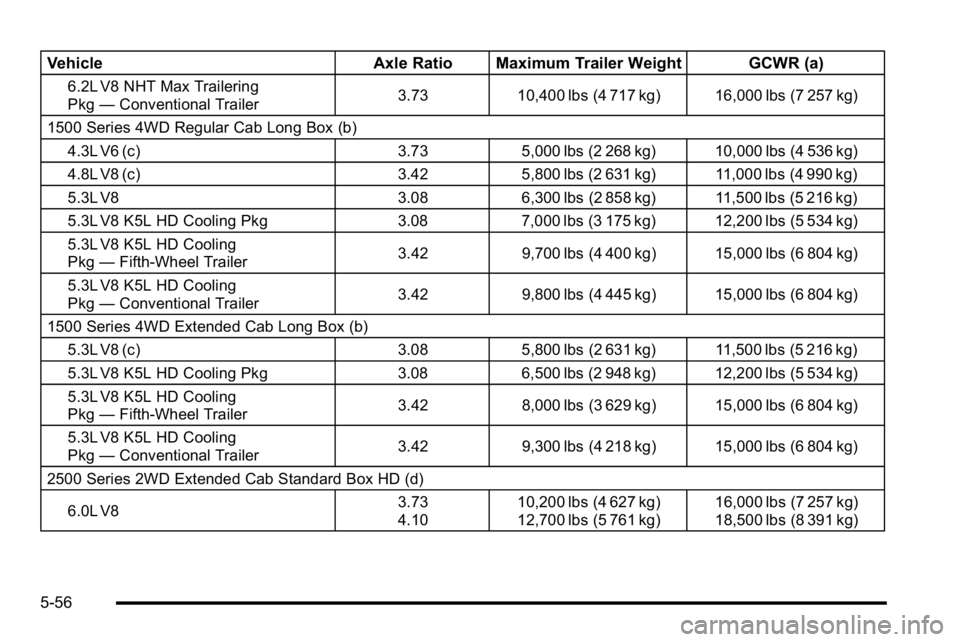
VehicleAxle Ratio Maximum Trailer Weight GCWR (a)
6.2L V8 NHT Max Trailering
Pkg—Conventional Trailer 3.73 10,400 lbs (4 717 kg) 16,000 lbs (7 257 kg)
1500 Series 4WD Regular Cab Long Box (b) 4.3L V6 (c) 3.73 5,000 lbs (2 268 kg) 10,000 lbs (4 536 kg)
4.8L V8 (c) 3.42 5,800 lbs (2 631 kg) 11,000 lbs (4 990 kg)
5.3L V8 3.08 6,300 lbs (2 858 kg) 11,500 lbs (5 216 kg)
5.3L V8 K5L HD Cooling Pkg 3.08 7,000 lbs (3 175 kg) 12,200 lbs (5 534 kg)
5.3L V8 K5L HD Cooling
Pkg —Fifth-Wheel Trailer 3.42
9,700 lbs (4 400 kg) 15,000 lbs (6 804 kg)
5.3L V8 K5L HD Cooling
Pkg —Conventional Trailer 3.42
9,800 lbs (4 445 kg) 15,000 lbs (6 804 kg)
1500 Series 4WD Extended Cab Long Box (b) 5.3L V8 (c) 3.085,800 lbs (2 631 kg) 11,500 lbs (5 216 kg)
5.3L V8 K5L HD Cooling Pkg 3.086,500 lbs (2 948 kg) 12,200 lbs (5 534 kg)
5.3L V8 K5L HD Cooling
Pkg —Fifth-Wheel Trailer 3.42
8,000 lbs (3 629 kg) 15,000 lbs (6 804 kg)
5.3L V8 K5L HD Cooling
Pkg —Conventional Trailer 3.42
9,300 lbs (4 218 kg) 15,000 lbs (6 804 kg)
2500 Series 2WD Extended Cab Standard Box HD (d) 6.0L V8 3.73
4.1010,200 lbs (4 627 kg)
12,700 lbs (5 761 kg) 16,000 lbs (7 257 kg)
18,500 lbs (8 391 kg)
5-56
Page 425 of 630
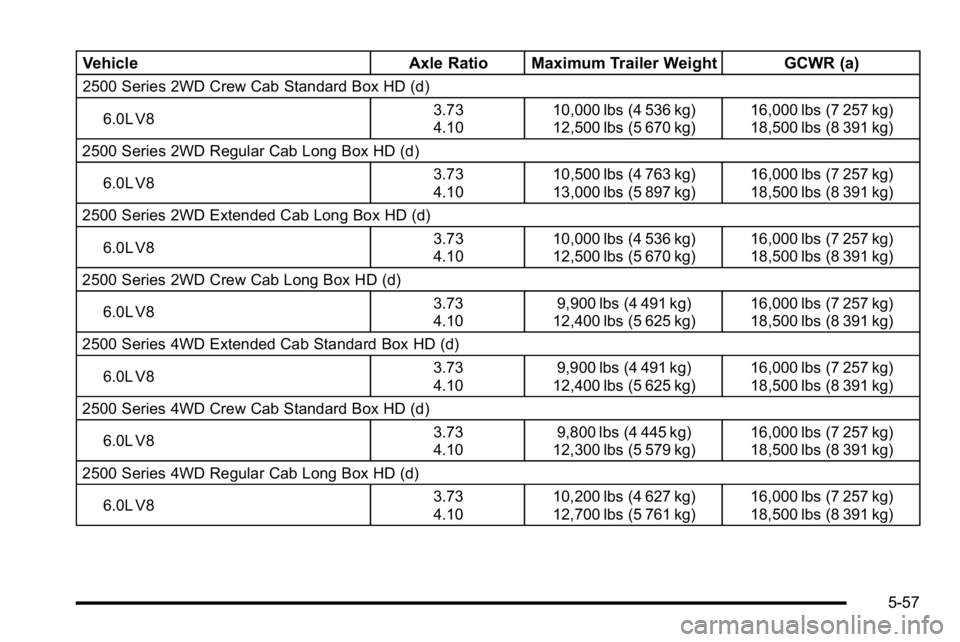
VehicleAxle Ratio Maximum Trailer Weight GCWR (a)
2500 Series 2WD Crew Cab Standard Box HD (d)
6.0L V8 3.73
4.1010,000 lbs (4 536 kg)
12,500 lbs (5 670 kg) 16,000 lbs (7 257 kg)
18,500 lbs (8 391 kg)
2500 Series 2WD Regular Cab Long Box HD (d)
6.0L V8 3.73
4.1010,500 lbs (4 763 kg)
13,000 lbs (5 897 kg) 16,000 lbs (7 257 kg)
18,500 lbs (8 391 kg)
2500 Series 2WD Extended Cab Long Box HD (d)
6.0L V8 3.73
4.1010,000 lbs (4 536 kg)
12,500 lbs (5 670 kg) 16,000 lbs (7 257 kg)
18,500 lbs (8 391 kg)
2500 Series 2WD Crew Cab Long Box HD (d)
6.0L V8 3.73
4.109,900 lbs (4 491 kg)
12,400 lbs (5 625 kg) 16,000 lbs (7 257 kg)
18,500 lbs (8 391 kg)
2500 Series 4WD Extended Cab Standard Box HD (d)
6.0L V8 3.73
4.109,900 lbs (4 491 kg)
12,400 lbs (5 625 kg) 16,000 lbs (7 257 kg)
18,500 lbs (8 391 kg)
2500 Series 4WD Crew Cab Standard Box HD (d)
6.0L V8 3.73
4.109,800 lbs (4 445 kg)
12,300 lbs (5 579 kg) 16,000 lbs (7 257 kg)
18,500 lbs (8 391 kg)
2500 Series 4WD Regular Cab Long Box HD (d)
6.0L V8 3.73
4.1010,200 lbs (4 627 kg)
12,700 lbs (5 761 kg) 16,000 lbs (7 257 kg)
18,500 lbs (8 391 kg)
5-57
Page 426 of 630
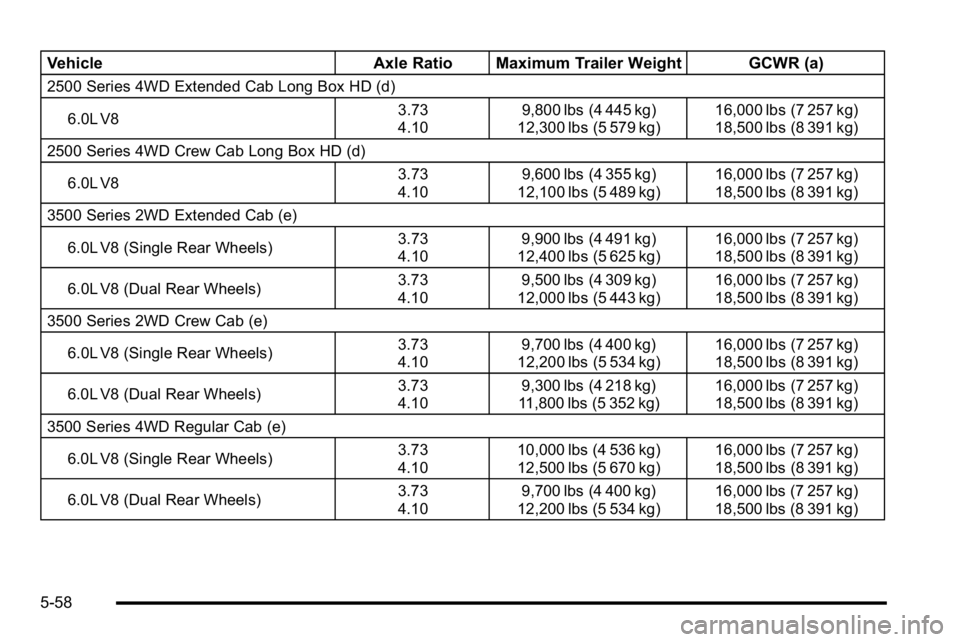
VehicleAxle Ratio Maximum Trailer Weight GCWR (a)
2500 Series 4WD Extended Cab Long Box HD (d)
6.0L V8 3.73
4.109,800 lbs (4 445 kg)
12,300 lbs (5 579 kg) 16,000 lbs (7 257 kg)
18,500 lbs (8 391 kg)
2500 Series 4WD Crew Cab Long Box HD (d)
6.0L V8 3.73
4.109,600 lbs (4 355 kg)
12,100 lbs (5 489 kg) 16,000 lbs (7 257 kg)
18,500 lbs (8 391 kg)
3500 Series 2WD Extended Cab (e)
6.0L V8 (Single Rear Wheels) 3.73
4.109,900 lbs (4 491 kg)
12,400 lbs (5 625 kg) 16,000 lbs (7 257 kg)
18,500 lbs (8 391 kg)
6.0L V8 (Dual Rear Wheels) 3.73
4.109,500 lbs (4 309 kg)
12,000 lbs (5 443 kg) 16,000 lbs (7 257 kg)
18,500 lbs (8 391 kg)
3500 Series 2WD Crew Cab (e)
6.0L V8 (Single Rear Wheels) 3.73
4.109,700 lbs (4 400 kg)
12,200 lbs (5 534 kg) 16,000 lbs (7 257 kg)
18,500 lbs (8 391 kg)
6.0L V8 (Dual Rear Wheels) 3.73
4.109,300 lbs (4 218 kg)
11,800 lbs (5 352 kg) 16,000 lbs (7 257 kg)
18,500 lbs (8 391 kg)
3500 Series 4WD Regular Cab (e)
6.0L V8 (Single Rear Wheels) 3.73
4.1010,000 lbs (4 536 kg)
12,500 lbs (5 670 kg) 16,000 lbs (7 257 kg)
18,500 lbs (8 391 kg)
6.0L V8 (Dual Rear Wheels) 3.73
4.109,700 lbs (4 400 kg)
12,200 lbs (5 534 kg) 16,000 lbs (7 257 kg)
18,500 lbs (8 391 kg)
5-58
Page 427 of 630
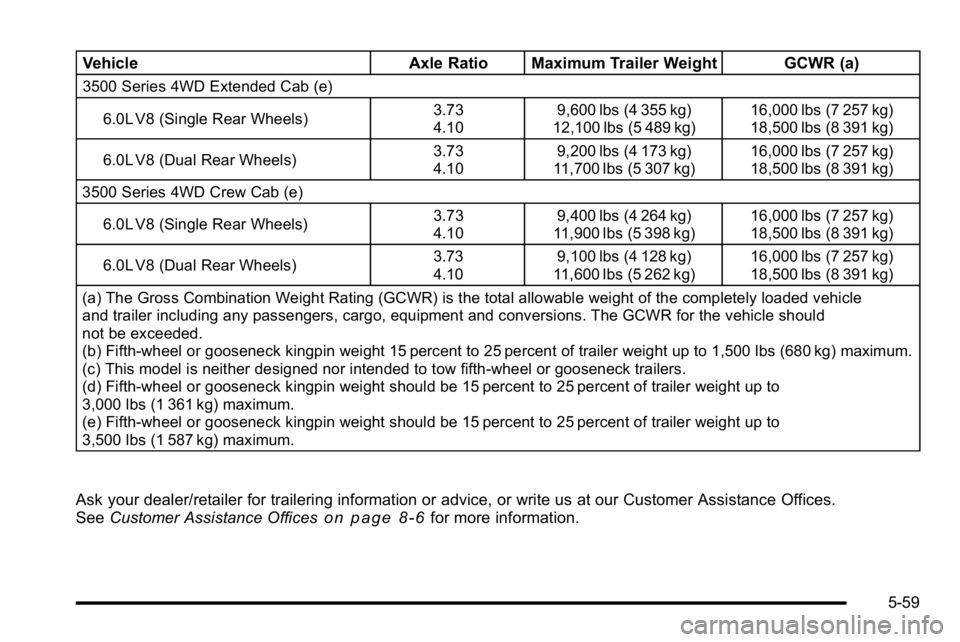
VehicleAxle Ratio Maximum Trailer Weight GCWR (a)
3500 Series 4WD Extended Cab (e)
6.0L V8 (Single Rear Wheels) 3.73
4.109,600 lbs (4 355 kg)
12,100 lbs (5 489 kg) 16,000 lbs (7 257 kg)
18,500 lbs (8 391 kg)
6.0L V8 (Dual Rear Wheels) 3.73
4.109,200 lbs (4 173 kg)
11,700 lbs (5 307 kg) 16,000 lbs (7 257 kg)
18,500 lbs (8 391 kg)
3500 Series 4WD Crew Cab (e)
6.0L V8 (Single Rear Wheels) 3.73
4.109,400 lbs (4 264 kg)
11,900 lbs (5 398 kg) 16,000 lbs (7 257 kg)
18,500 lbs (8 391 kg)
6.0L V8 (Dual Rear Wheels) 3.73
4.109,100 lbs (4 128 kg)
11,600 lbs (5 262 kg) 16,000 lbs (7 257 kg)
18,500 lbs (8 391 kg)
(a) The Gross Combination Weight Rating (GCWR) is the total allowable weight of the completely loaded vehicle
and trailer including any passengers, cargo, equipment and conversions. The GCWR for the vehicle should
not be exceeded.
(b) Fifth-wheel or gooseneck kingpin weight 15 percent to 25 percent of trailer weight up to 1,500 lbs (680 kg) maximum.
(c) This model is neither designed nor intended to tow fifth-wheel or gooseneck trailers.
(d) Fifth-wheel or gooseneck kingpin weight should be 15 percent to 25 percent of trailer weight up to
3,000 lbs (1 361 kg) maximum.
(e) Fifth-wheel or gooseneck kingpin weight should be 15 percent to 25 percent of trailer weight up to
3,500 lbs (1 587 kg) maximum.
Ask your dealer/retailer for trailering information or advice, or write us at our Customer Assistance Offices.
See Customer Assistance Officeson page 8‑6for more information.
5-59
Page 428 of 630
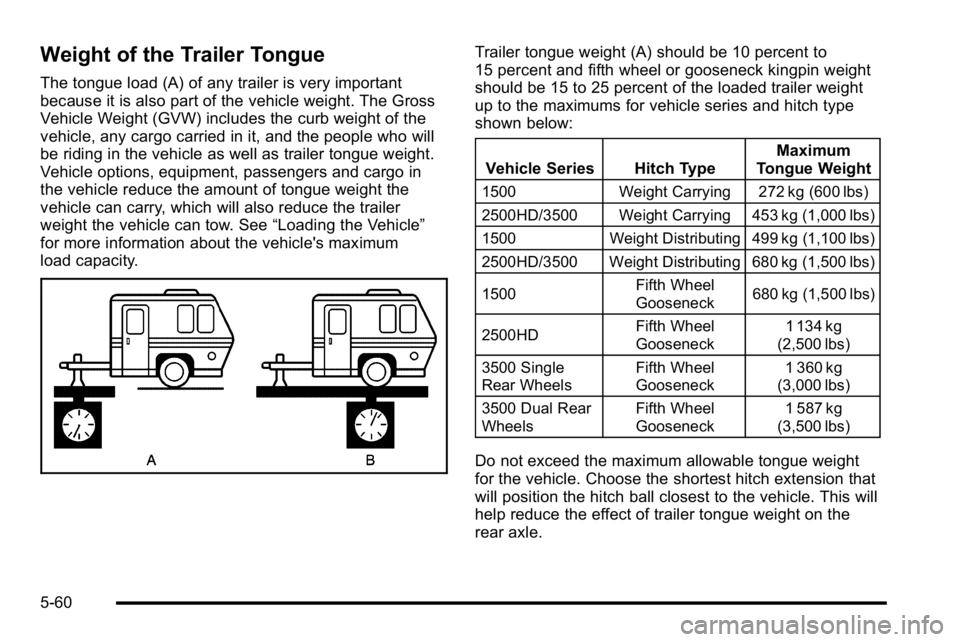
Weight of the Trailer Tongue
The tongue load (A) of any trailer is very important
because it is also part of the vehicle weight. The Gross
Vehicle Weight (GVW) includes the curb weight of the
vehicle, any cargo carried in it, and the people who will
be riding in the vehicle as well as trailer tongue weight.
Vehicle options, equipment, passengers and cargo in
the vehicle reduce the amount of tongue weight the
vehicle can carry, which will also reduce the trailer
weight the vehicle can tow. See“Loading the Vehicle”
for more information about the vehicle's maximum
load capacity.
Trailer tongue weight (A) should be 10 percent to
15 percent and fifth wheel or gooseneck kingpin weight
should be 15 to 25 percent of the loaded trailer weight
up to the maximums for vehicle series and hitch type
shown below:
Vehicle Series Hitch Type Maximum
Tongue Weight
1500 Weight Carrying 272 kg (600 lbs)
2500HD/3500 Weight Carrying 453 kg (1,000 lbs)
1500 Weight Distributing 499 kg (1,100 lbs)
2500HD/3500 Weight Distributing 680 kg (1,500 lbs)
1500 Fifth Wheel
Gooseneck
680 kg (1,500 lbs)
2500HD Fifth Wheel
Gooseneck1 134 kg
(2,500 lbs)
3500 Single
Rear Wheels Fifth Wheel
Gooseneck1 360 kg
(3,000 lbs)
3500 Dual Rear
Wheels Fifth Wheel
Gooseneck1 587 kg
(3,500 lbs)
Do not exceed the maximum allowable tongue weight
for the vehicle. Choose the shortest hitch extension that
will position the hitch ball closest to the vehicle. This will
help reduce the effect of trailer tongue weight on the
rear axle.
5-60
Page 429 of 630
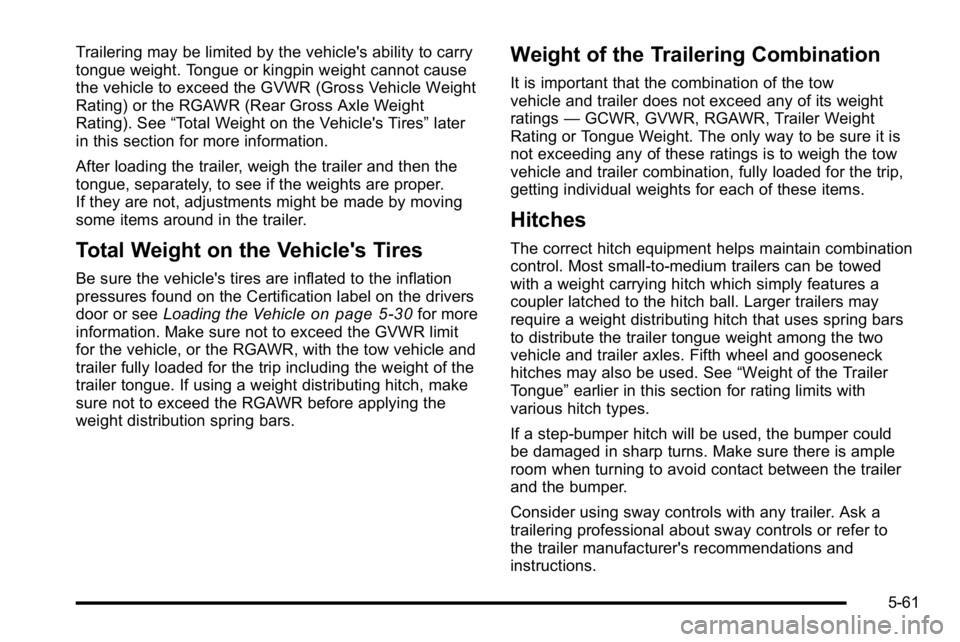
Trailering may be limited by the vehicle's ability to carry
tongue weight. Tongue or kingpin weight cannot cause
the vehicle to exceed the GVWR (Gross Vehicle Weight
Rating) or the RGAWR (Rear Gross Axle Weight
Rating). See“Total Weight on the Vehicle's Tires” later
in this section for more information.
After loading the trailer, weigh the trailer and then the
tongue, separately, to see if the weights are proper.
If they are not, adjustments might be made by moving
some items around in the trailer.
Total Weight on the Vehicle's Tires
Be sure the vehicle's tires are inflated to the inflation
pressures found on the Certification label on the drivers
door or see Loading the Vehicle
on page 5‑30for more
information. Make sure not to exceed the GVWR limit
for the vehicle, or the RGAWR, with the tow vehicle and
trailer fully loaded for the trip including the weight of the
trailer tongue. If using a weight distributing hitch, make
sure not to exceed the RGAWR before applying the
weight distribution spring bars.
Weight of the Trailering Combination
It is important that the combination of the tow
vehicle and trailer does not exceed any of its weight
ratings —GCWR, GVWR, RGAWR, Trailer Weight
Rating or Tongue Weight. The only way to be sure it is
not exceeding any of these ratings is to weigh the tow
vehicle and trailer combination, fully loaded for the trip,
getting individual weights for each of these items.
Hitches
The correct hitch equipment helps maintain combination
control. Most small-to-medium trailers can be towed
with a weight carrying hitch which simply features a
coupler latched to the hitch ball. Larger trailers may
require a weight distributing hitch that uses spring bars
to distribute the trailer tongue weight among the two
vehicle and trailer axles. Fifth wheel and gooseneck
hitches may also be used. See “Weight of the Trailer
Tongue” earlier in this section for rating limits with
various hitch types.
If a step-bumper hitch will be used, the bumper could
be damaged in sharp turns. Make sure there is ample
room when turning to avoid contact between the trailer
and the bumper.
Consider using sway controls with any trailer. Ask a
trailering professional about sway controls or refer to
the trailer manufacturer's recommendations and
instructions.
5-61
Page 430 of 630
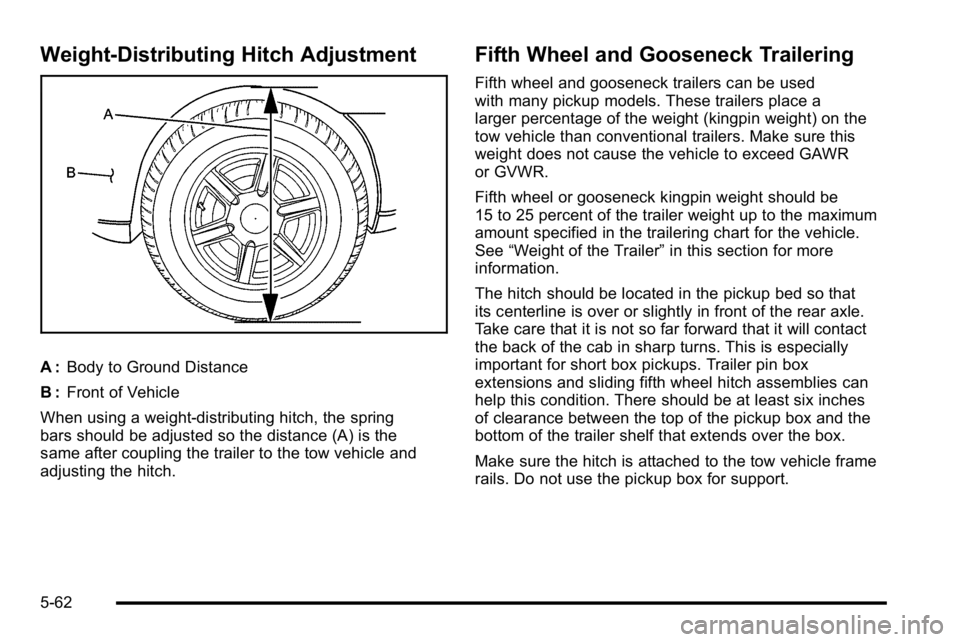
Weight‐Distributing Hitch Adjustment
A :Body to Ground Distance
B : Front of Vehicle
When using a weight-distributing hitch, the spring
bars should be adjusted so the distance (A) is the
same after coupling the trailer to the tow vehicle and
adjusting the hitch.
Fifth Wheel and Gooseneck Trailering
Fifth wheel and gooseneck trailers can be used
with many pickup models. These trailers place a
larger percentage of the weight (kingpin weight) on the
tow vehicle than conventional trailers. Make sure this
weight does not cause the vehicle to exceed GAWR
or GVWR.
Fifth wheel or gooseneck kingpin weight should be
15 to 25 percent of the trailer weight up to the maximum
amount specified in the trailering chart for the vehicle.
See “Weight of the Trailer” in this section for more
information.
The hitch should be located in the pickup bed so that
its centerline is over or slightly in front of the rear axle.
Take care that it is not so far forward that it will contact
the back of the cab in sharp turns. This is especially
important for short box pickups. Trailer pin box
extensions and sliding fifth wheel hitch assemblies can
help this condition. There should be at least six inches
of clearance between the top of the pickup box and the
bottom of the trailer shelf that extends over the box.
Make sure the hitch is attached to the tow vehicle frame
rails. Do not use the pickup box for support.
5-62